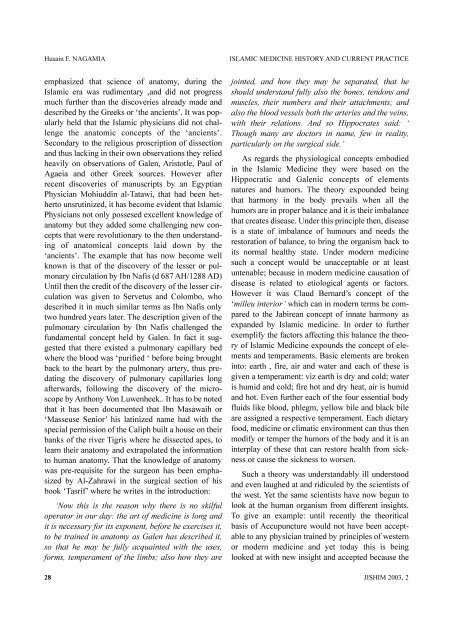Islamic Medicine History and Current Practice - International Society ...
Islamic Medicine History and Current Practice - International Society ...
Islamic Medicine History and Current Practice - International Society ...
- No tags were found...
Create successful ePaper yourself
Turn your PDF publications into a flip-book with our unique Google optimized e-Paper software.
Husain F. NAGAMIAISLAMIC MEDICINE HISTORY AND CURRENT PRACTICEemphasized that science of anatomy, during the<strong>Islamic</strong> era was rudimentary ,<strong>and</strong> did not progressmuch further than the discoveries already made <strong>and</strong>described by the Greeks or ‘the ancients’. It was popularlyheld that the <strong>Islamic</strong> physicians did not challengethe anatomic concepts of the ‘ancients’.Secondary to the religious proscription of dissection<strong>and</strong> thus lacking in their own observations they reliedheavily on observations of Galen, Aristotle, Paul ofAgaeia <strong>and</strong> other Greek sources. However afterrecent discoveries of manuscripts by an EgyptianPhysician Mohiuddin al-Tatawi, that had been hethertounsrutinized, it has become evident that <strong>Islamic</strong>Physicians not only possesed excellent knowledge ofanatomy but they added some challenging new conceptsthat were revolutionary to the then underst<strong>and</strong>ingof anatomical concepts laid down by the‘ancients’. The example that has now become wellknown is that of the discovery of the lesser or pulmonarycirculation by Ibn Nafis (d 687 AH/1288 AD)Until then the credit of the discovery of the lesser circulationwas given to Servetus <strong>and</strong> Colombo, whodescribed it in much similar terms as Ibn Nafis onlytwo hundred years later. The description given of thepulmonary circulation by Ibn Nafis challenged thefundamental concept held by Galen. In fact it suggestedthat there existed a pulmonary capillary bedwhere the blood was ‘purified ‘ before being broughtback to the heart by the pulmonary artery, thus predatingthe discovery of pulmonary capillaries longafterwards, following the discovery of the microscopeby Anthony Von Luwenheek.. It has to be notedthat it has been documented that Ibn Masawaih or‘Masseuse Senior’ his latinized name had with thespecial permission of the Caliph built a house on theirbanks of the river Tigris where he dissected apes, tolearn their anatomy <strong>and</strong> extrapolated the informationto human anatomy. That the knowledge of anatomywas pre-requisite for the surgeon has been emphasizedby Al-Zahrawi in the surgical section of hisbook ‘Tasrif’ where he writes in the introduction:‘Now this is the reason why there is no skilfuloperator in our day: the art of medicine is long <strong>and</strong>it is necessary for its exponent, before he exercises it,to be trained in anatomy as Galen has described it,so that he may be fully acquainted with the uses,forms, temperament of the limbs; also how they arejointed, <strong>and</strong> how they may be separated, that heshould underst<strong>and</strong> fully also the bones, tendons <strong>and</strong>muscles, their numbers <strong>and</strong> their attachments; <strong>and</strong>also the blood vessels both the arteries <strong>and</strong> the veins,with their relations. And so Hippocrates said: ‘Though many are doctors in name, few in reality,particularly on the surgical side.’As regards the physiological concepts embodiedin the <strong>Islamic</strong> <strong>Medicine</strong> they were based on theHippocratic <strong>and</strong> Galenic concepts of elementsnatures <strong>and</strong> humors. The theory expounded beingthat harmony in the body prevails when all thehumors are in proper balance <strong>and</strong> it is their imbalancethat creates disease. Under this principle then, diseaseis a state of imbalance of humours <strong>and</strong> needs therestoration of balance, to bring the organism back toits normal healthy state. Under modern medicinesuch a concept would be unacceptable or at leastuntenable; because in modern medicine causation ofdisease is related to etiological agents or factors.However it was Claud Bernard’s concept of the‘milleu interior’ which can in modern terms be comparedto the Jabirean concept of innate harmony asexp<strong>and</strong>ed by <strong>Islamic</strong> medicine. In order to furtherexemplify the factors affecting this balance the theoryof <strong>Islamic</strong> <strong>Medicine</strong> expounds the concept of elements<strong>and</strong> temperaments. Basic elements are brokeninto: earth , fire, air <strong>and</strong> water <strong>and</strong> each of these isgiven a temperament: viz earth is dry <strong>and</strong> cold; wateris humid <strong>and</strong> cold; fire hot <strong>and</strong> dry heat, air is humid<strong>and</strong> hot. Even further each of the four essential bodyfluids like blood, phlegm, yellow bile <strong>and</strong> black bileare assigned a respective temperament. Each dietaryfood, medicine or climatic environment can thus thenmodify or temper the humors of the body <strong>and</strong> it is aninterplay of these that can restore health from sicknessor cause the sickness to worsen.Such a theory was underst<strong>and</strong>ably ill understood<strong>and</strong> even laughed at <strong>and</strong> ridiculed by the scientists ofthe west. Yet the same scientists have now begun tolook at the human organism from different insights.To give an example: until recently the theoriticalbasis of Accupuncture would not have been acceptableto any physician trained by principles of westernor modern medicine <strong>and</strong> yet today this is beinglooked at with new insight <strong>and</strong> accepted because the28 JISHIM 2003, 2
















